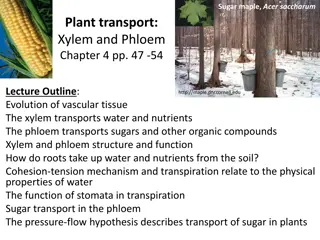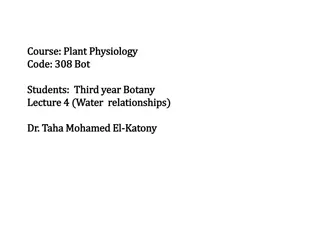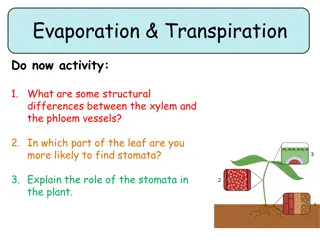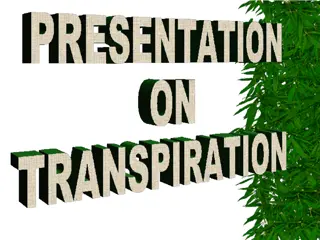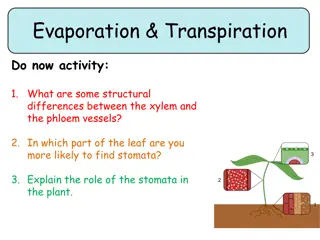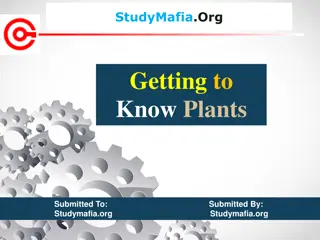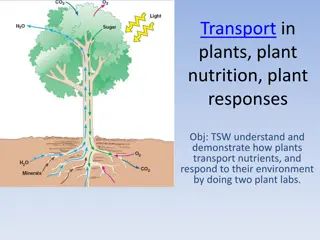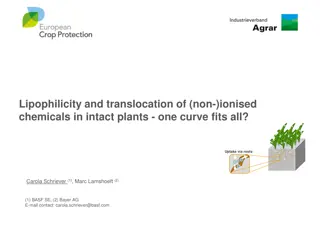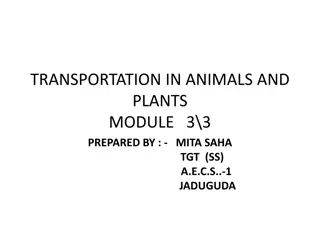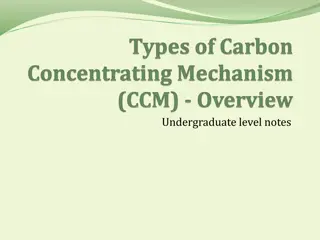Understanding Transpiration in Plants: Importance and Mechanisms
Transpiration is the process in which plants lose water vapor through their aerial parts, playing a crucial role in their overall functioning. This loss of water occurs mainly through stomata, lenticels, and the cuticle of leaves and stems. Different types of transpiration like stomatal, lenticular, and cuticular transpiration contribute to plant water regulation. The structure of stomata, with guard cells controlling their opening and closing mechanisms, is essential for this process. Understanding transpiration is key to comprehending how plants maintain their water balance and regulate various physiological functions.
Download Presentation

Please find below an Image/Link to download the presentation.
The content on the website is provided AS IS for your information and personal use only. It may not be sold, licensed, or shared on other websites without obtaining consent from the author. Download presentation by click this link. If you encounter any issues during the download, it is possible that the publisher has removed the file from their server.
E N D
Presentation Transcript
Transpiration and Its Significance Dr. Habibur Rahman Associate Professor J. N. College, Boko
Introduction: The loss of water in the form of vapor from the living tissues of aerial parts of plant such as leaf, stem, leaves etc. is termed as transpiration. The plants uptake abundant quantity of water from the soil through their root hairs. Some portion of the water is utilized in the metabolic activities of the plant whereas rest of them are evaporated from the stem and the leaves. Transpiration takes place through stomata, lenticels or cuticle(A lenticel is a porous tissue consisting of cells with large intercellular spaces in the periderm of the secondarily thickened organs and the bark of woody stems and roots of dicotyledonous flowering plants). Transpiration is a metabolic process regulated by protoplasm and may be decreased or increased where needed by the nature. It differs from evaporation in fact that transpiration being a physiological process while evaporation is a physical process. The rate of transpiration is measured by potometer.
Types of transpiration in plants: Transpiration takes place through surface of leaves. It is known as Foliar transpiration (more than 90%). Transpiration occurs through young or mature stem is called as Cauline transpiration. On the basis of site of transpiration, there are three types of transpiration. They are: 1. Stomatal transpiration: It occurs through the stomata situated on the leaves and sometimes on the green stems. It is the most important one. Almost 90-97% of the total transpiration occurs through the stomata. 2. Lenticular transpiration: It occurs through the lenticels found on the stem. The stomata remain closed during night and the plant transpire through lenticels. 3. Cuticular transpiration: It takes place through the cuticle found on the surface of the stem and leaves.
Structure of stomata: The stomata are very minute apertures, found on the epidermis of the leaves. Each stoma is surrounded by two kidney-shaped special epidermal cells, known as guard cells. The epidermal cells surrounding the guard cells of the stoma are known as accessory or subsidiary cells. The number of stomata may range from thousands to lacs per square centimeter on the surface of the leaf. Each stoma is surrounded by two guard cells. The kidney-shaped guard cells contain chloroplasts.
Stomatal mechanism in plant cells: The mechanism of the closing and opening of the stomata depends upon the presence of sugar and starch in the guard cells. During day time or in the presence of light, the guard cells of the stomata contain sugar synthesized by their chloroplasts. The sugar is soluble and increases the concentration of the sap of guard cells. Due to higher concentration of the cytoplasm of guard cells, the water comes to them from the neighbouring cells by Endosmosis and they become turgid. With the result the stomata remain open. In the night or in the absence of light the sugar present in guard cells converts into the starch. The starch is insoluble, and this way the cell sap of the guard cells remains of much lower concentration than those of neighbouring cells, and the neighbouring cells take out the water from the guard cells by Exosmosis making them flaccid and the stomata closed.
Structure of stomata: The stomata (stoma, singular) are microscopic apertures commonly found on the epidermis of leaves, green fruits and herbaceous stems. Stomata are never present in roots. It is biconvex elliptical in structure. The two kidney-shaped special epidermal cells termed as guard cells surrounds each stoma. The guard cells are filled with thin layer of cytoplasm and central large vacuole. The cell wall of guard cells surrounding the stomatal pores is thicker and inelastic because of the formation of secondary layer of cellulose, while rest cell wall is thin and elastic. The epidermal cells that surrounds the guard cells of the stoma are termed as accessory or subsidiary cells.
The guard cells are always living and consists of small chloroplasts unlike other epidermal cells. In case of dicotyledonous leaves, the stomata are found scattered whereas in case of monocotyledonous leaves, the stomata are arranged in parallel rows. The stomata may be found on both the surface of the leaf, but their number is always greater on the lower surface. Shape, size and number of stomata: The shape of guard cells in case of dicots is reniform or kidney shaped whereas in case of monocots, it is dumb-bell shaped. The size of stoma varies from species to species and measures 3- 12 . The number of stomata can vary from thousands to lacs per square centimetre on the surface of the leaf.
Mechanisms of opening and closing of stomata: In normal condition, the stomata remain closed in the absence of light. In the day time or in the presence of light, stomata are always open. Under each stoma, a respiratory cavity is present. The mechanism of the closing and opening of the stomata relies upon the presence of sugar and starch in the guard cells. Starch-sugar inter conversion hypothesis: This hypothesis states that the opening and closing of stomata is controlled by phosphorylase enzyme. During daytime, the starch converts into glucose (sugar) by the activity of phosphorylase enzyme. The increasing concentration of sugar in the guard cells causes endosmosis from neighboring cells. Hence, the guard cells become turgid and stomata opens The sugar present in guard cell converts into the starch in the absence of light or during night.
The starch is insoluble, and hence the cell sap of the guard cell remains of much lower concentration in comparison to neighboring cells. Exosmosis from the guard cells takes place by making them flaccid and the stomata is closed. The starch-sugar inter-conversion depends upon the acidity (pH) and alkalinity of the cell sap of guard cells. During night, photosynthesis is absent thus the carbon dioxide gets accumulated in the guard cells. This converts the cell sap in to weak acidic starch. The carbon dioxide is utilized in the process of photosynthesis during daytime and the cell sap becomes alkaline and the starch converts in to sugar.
Concentrations of CO2 hypothesis: This hypothesis for opening and closing of stomata was proposed by Bonner and Galston. It relies upon the concentration of the carbon dioxide (CO2) present in the stomatal chamber. It is independent of the presence or absence of light. Normally 0.03% of carbon dioxide is present in the atmosphere. When the density of the CO2 in the sub stomatal chamber also becomes 0.03%, then the guard cells become flaccid and the stomata becomes closed. As the density of CO2 decreases gradually, the stoma starts to open and it opens gradually lengthwise until the density of CO2 becomes 0.01%. Now the stomata are completely open and they are not open further beyond this density. The photosynthesis occurs in day time and much of the carbon dioxide is being utilized in the process, the density becomes lesser than 0.03% and the stomata stays open during day time.
During night or in the darkness, photosynthesis is absent, the density of carbon dioxide remains 0.03%. The guard cell remains flaccid and the stomata remains closed. Active potassium (K Active potassium (K+ +) theory: This theory is also termed as hormonal regulation theory or malate switch theory or potassium malate theory. This theory was proposed by Levitt in 1974. The role of potassium (K+) in stomatal opening is now most accepted world- wide. In 1967, Fujino, for the first time observed that opening of stomata takes place due to the influx of K+ions concentration. The osmotic concentration of guard cells is increased by the influx of K+and causes stomatal opening. The uptake of potassium K+controls the gradient in the water potential. ) theory:
This in turn triggers endosmosis into the guard cells increasing the turgor pressure. ATP aids in entry of K+ ions into the guard cells. Levitt (1974) observed that proton (H+) uptake by the guard cell s chloroplasts occurs with the help of ATP. This leads to rise of pH in guard cells. Increase in pH converts starch into organic acid, such as malic acid. Malic acid again dissociates to form H+ and malate anion. The absorption of potassium K+ ions is balanced by one of the following: Uptake of Cl- Transport of H+ions from organic acids, such as malic acid By negative charges of organic acids when they lose H+ions The accumulation of large concentration of K+ ions in guard cells is ionically balanced by the uptake of negatively charged ions, i.e., chloride and malate. The hydrolysis of starch causes the accumulation of high amount of malate in guard cells of open stomata. A passive or highly catalyzed excretion of K+ and Cl from the guard cells to the epidermal tissue results in stomatal closure in general and subsidiary cells in particular. It is considered that subsidiary cells have an active re-absorption mechanism of K+.
Opening of Stomata during Daytime (in presence of light): Opening of stomata depends upon following conditions: (a) In Presence of light. (b) Decrease in starch contents of guard cells. (c) Increased concentration of malic acid in guard cells. (d) Influx of K+ ions into guard cells. (e) Efflux of H+ ions from guard cells. (f) Intake of CI ions by guard cells. (g) Low CO2 concentration in an around guard cells. (h) High pH (more than 7) in guard cells (hence, alkaline medium of the cell sap in guard cells). (i) High Turgor Pressure in guard cells due to endosmosis, (turgidity of cells). (j) And stomata open.
Closing of Stomata in Absence of Light (Darkness/Night Time): Closing of stomata depends on following conditions: (a) Absence of light. (b) Decreased concentration of malic acid in guard cells. (c) Efflux of K+ ions from guard cells. (d) Influx of H+ ions in guard cells. (e) Acidic medium of the cell sap in guard cells. (f) Loss of Cl ions from guard cells. (g) Increases CO2 concentration in and around guard cell due to release of CO2 in respiration combined with the absence of photosynthetic activity in dark. (h) Presence of plant growth inhibiting hormone abscissic acid (ABA), (i) Loss of turgidity and loss of kidney-shape by guard cells. All these conditions represent the reversal of the daytime events. Under these conditions, the guard cells lose water by exosmosis and become flaccid. This causes closing of the stomata.
Factors Affecting Transpiration in Plants 1. Humidity of Air: has influence on Transpiration. On damp foggy atmosphere the rate of transpiration decreases as the outer air remains saturated with water vapour. The less moisture there is in air, the greater will be the rate of transpiration. Humidity or amount of water vapour in the atmosphere, surrounding the plant 2. Light or Illumination: The opening and closing of the stomata depend on light. due to absorption of radiant energy and its transformation into heat, temperature of the leaf is raised bringing about an increase in transpiration rates. 3. Temperature: It increases the rate of transpiration as it hastens transformation of water into water vapour.
4. Wind: By wind or air current water vapour given off during transpiration is removed; thus saturation of the surrounding air is avoided which otherwise would retard the rate of transpiration. Winds of high however, retard transpiration, because the stomata close up due to high winds. Moreover, winds of high velocity bring about a reduction in temperature which undoubtedly affects transpiration. 5. Atmospheric Pressure: When atmospheric pressure is high, the rate of transpiration is low. Plants growing in high altitudes have distinctly lower atmospheric pressures, and those plants have high rates of transpiration, if other environmental factors are not limiting. 6. Soil Factors: As all necessary water is absorbed from the soil, factors like water content, composition, temperature, concentration of soil solution, etc., indirectly influence the rate of transpiration.
Significance of transpiration: As transpiration helps in the movement of xylem sap, it increases the absorption of mineral nutrients by the roots from the soil. It causes cooling effect on leaf and plant surface. It produces suction pressure for absorption, ascent of sap, mineral translocation and distribution of minerals. Transpiration decreases heating of leaves by solar radiations. It maintains turgidity as well as aids in hydrological cycle.
Disadvantages of transpiration: The energy used during absorption is wasted. Unwanted loss of water. Excess transpiration causes wilting that is harmful for plants. It increases acidity, alkalinity or aridity of soil.


